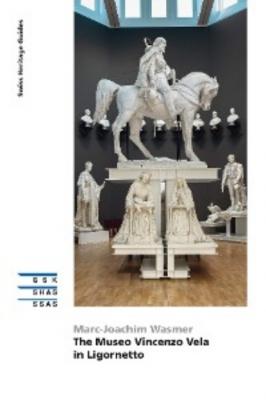The Museo Vincenzo Vela in Ligornetto. Marc-Joachim Wasmer
Читать онлайн.| Название | The Museo Vincenzo Vela in Ligornetto |
|---|---|
| Автор произведения | Marc-Joachim Wasmer |
| Жанр | Архитектура |
| Серия | |
| Издательство | Архитектура |
| Год выпуска | 0 |
| isbn | 9783037976753 |
Lorenzo Vela, The Monkey Carving a Chicken, undated, plaster original.
Lorenzo Vela (1812–1897)
Eight years older than his brother Vincenzo, Lorenzo Vela was born in Ligornetto on 4 July 1812. He began his training in 1832 in Milan as a stonecutter at Brera Academy, attending courses with the Ticinese Ferdinando Albertolli (1781–1844) in the Scuola d’Ornato. Stylistically, he is associated with the sculptor Benedetto Cacciatori (1793–1871), with whom he worked as the main collaborator in the beginning of his artistic career. From 1860 to 1891, he taught decorative sculpture at Brera, passing on his eclectic, historicist style to the successive generation of artists. He died in Milan on 10 January 1897.
Following the example of Vincenzo and Spartaco Vela, he bequeathed his possessions to the Swiss Confederation, including his prestigious collection of 19th century Lombard and Piedmontese paintings.
A respected artist himself during his lifetime, he is considered the true discoverer of Vincenzo Vela and was in fact soon eclipsed by his celebrated brother. Beginning in the early 1830s as a specialist in decorative sculpture in and around Milan, Lorenzo was in charge of decorating many buildings and tombs, by means of which he also created opportunities for his brother Vincenzo to work with the Lombard elite. The two brothers collaborated on various occasions, for example, on the Chapel of the Villa Borromeo d’Adda in Arcore. Beginning in the 1840s, Lorenzo concentrated on animal and genre sculptures made of plaster, marble and terracotta. While Lorenzo’s autonomous works such as Interrupted Study (V) and Victim of the Inquisition (1860) show an affinity with Vincenzo Vela’s stylistic language, they have a more sentimental quality and do not achieve Vincenzo’s impressive formal refinement (see V and VII).
Spartaco Vela (1854–1895)
Born in Turin on 23 March 1854, Spartaco Vela – the only son of Vincenzo Vela and the Milanese Sabina Vela Dragoni – settled in Ligornetto with his parents in 1867. After an early interest in science and medicine, Spartaco devoted himself to painting in accordance with the wishes of his father, who sent him to study with his friends Giuseppe Bertini and Eleuterio Pagliano at Brera Academy in the early 1870s. There he established a close relationship with the painter Mosè Bianchi and other artists on the Lombard scene, although he personally was not part of any particular group. He spent the last years of his life gravely ill in Ligornetto, where he died at the age of forty-one. As the executor of Vincenzo Vela’s will, he donated the house and all his father’s possessions to the Swiss Confederation.
The burden of expectations weighed heavily on Vincenzo’s introverted son. Despite his undeniable talent, he was never able to escape beyond the sphere of expertise of his father, whose work was inevitably the touchstone by which Spartaco’s work was judged. Although he was a skilled draughtsman, watercolourist and painter, he garnered little recognition, even from his artist friends. His artistic output was limited and few of his works are actually finished, and yet his works were favourably received in his day.
Carlo Felice Biscarra, Portrait of Lorenzo Vela, c. 1855, oil on canvas.
Cesare Tallone, Portrait of Spartaco Vela (detail), c. 1880, oil on canvas.
Spartaco Vela, Rizpah Watching Over the Bodies of her Sons, 1881, oil on canvas.
His paintings with biblical or historical content clearly show the influence of Bertini and Pagliano while also referencing themes found in Vincenzo Vela’s work. One such painting is the large Rispa (2 Samuel, 21, 8–14; XX), which Spartaco exhibited in Milan in 1881 and at the first Swiss National Exposition in Zurich in 1883, along with his father’s relief The Victims of Labour (VII). His genre scenes and landscapes painted en plein air are associated with Lombard ‘Impressionism’ – an Italian version of the French artistic movement – especially as seen in the work of Eugenio Gignous (1850–1906). Although the eroticized themes with female figures appear rather inopportune today, they corresponded to the taste of the upper middle class of the time. He also produced lively portraits and nudes in the style of the group of artists known as ‘Scapigliatura’, using his mistresses as models.
Конец ознакомительного фрагмента.
Текст предоставлен ООО «ЛитРес».
Прочитайте эту книгу целиком, купив полную легальную версию на ЛитРес.
Безопасно оплатить книгу можно банковской картой Visa, MasterCard, Maestro, со счета мобильного телефона, с платежного терминала, в салоне МТС или Связной, через PayPal, WebMoney, Яндекс.Деньги, QIWI Кошелек, бонусными картами или другим удобным Вам способом.
